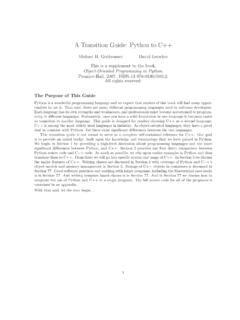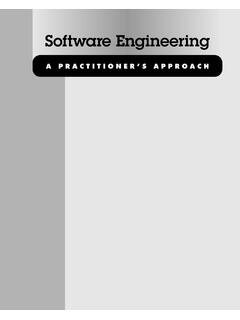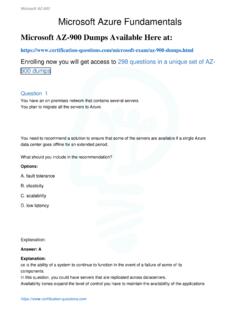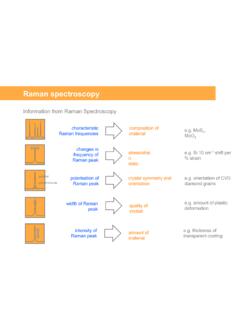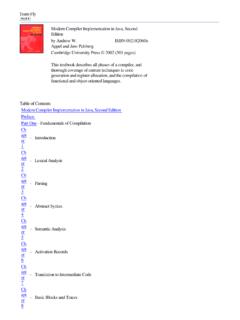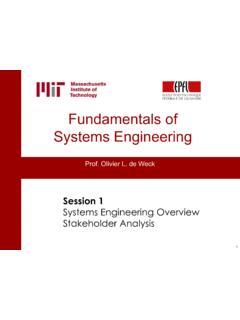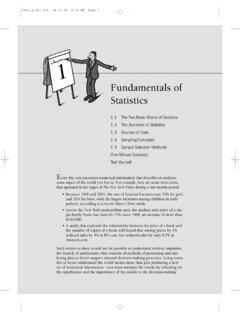Transcription of AZ-900: AZURE FUNDAMENTALS - Software Architect and …
1 1 AZ-900: AZURE FUNDAMENTALS COURSE ON UDEMY, document INSTRUCTOR: SCOTT DUFFY WITH KEVIN SCOTT Document and associated video course, 2019-2020, Scott Duffy and 2 Table of Contents SECTION 1: Intro to Course 4 The exam covers: 4 Who s the Exam For? 4 SECTION 2: Cloud Concepts (20-25%) 5 Benefits of Cloud Computing 5 Benefits of Cloud Services 5 Categories of Cloud Services 7 Types of Cloud Computing 8 For Further Reading: 9 SECTION 3: Core AZURE Services (15-20%) 10 AZURE Architectural Components 10 AZURE Subscriptions 12 12 Core AZURE Products 12 SECTION 4: Core Solutions and Management Tools (10-15%) 16 Core AZURE Solutions 16 AZURE Management Tools 17 For Further Reading: 18 SECTION 5: General Security and Network Security (10-15%) 19 3 Security features 19 Network Security 19 SECTION 6.
2 Identity, Governance, Privacy, Compliance (20-25%) 21 AZURE Identity Services 21 AZURE Governance Features 21 Privacy and Compliance Resources 22 For Further Reading: 24 SECTION 7: Cost Management and SLA (10-15%) 25 Planning and Management of Costs 25 AZURE SLAs 26 For Further Reading: 26 SECTION 8: Is that the end? 27 Thanks! 27 4 SECTION 1: Intro to Course The exam covers the topics on the following page: Passing the exam gets you the Microsoft Certified AZURE FUNDAMENTALS badge. The certification has no expiry date. Good for life . Optional exam.
3 Not a prerequisite to any of the other Microsoft Exams. But it s a good way to get a solid understanding of AZURE before jumping in to the future exams. Currently $99 USD. Available in English, Japanese, Chinese (Simplified), Korean, Spanish, German, and French The exam covers: Describe cloud concepts (20-25%) Describe core AZURE services (15-20%) Describe core solutions and management tools on AZURE (10-15%) Describe general security and network security features (10-15%) Describe identity, governance, privacy, and compliance features (20-25%) Describe AZURE cost management and Service Level Agreements (10-15%) Who s the Exam For?
4 Candidates with non-technical backgrounds, such as those involved in selling or purchasing cloud based solutions and services or who have some involvement with cloud based solutions and services, and Candidates with a technical background who have a need to validate their foundational level knowledge around cloud services. 5 SECTION 2: Cloud Concepts (20-25%) Benefits of Cloud Computing Cloud computing is: The ability to rent computing services of all types (compute, storage, networking, database, machine learning, etc.) Available for use in only a few minutes Only pay for what you use No contract or long-term commitment This ability unlocks so much value in the ability of businesses (like mine and yours) to deliver our products and services to the end users.
5 Cloud computing provides: Reduced up-front investment required Ongoing, monthly cost savings to the business (you) Vast catalog of computing services that you are able to use to serve your customers that wouldn t otherwise be available to you With increased performance, availability and security to the end user Benefits of Cloud Services Availability - what percentage of time does a system respond properly to requests, expressed as a percentage over time availability implies up to 4 minutes per month of acceptable downtime High Availability - a system specifically designed to be resilient when some component of the system fails 6 Scalability - the ability of a system to grow it s capacity easily when a system reaches its maximum capacity Elasticity - the ability of a system to automatically grow when maximum capacity is reached.
6 And automatically shrink to minimize waste Agility - the ability to respond to change rapidly based on changes to market or environment Disaster Recovery - the ability to recover from a big failure within an acceptable period of time, with an acceptable amount of data lost Microsoft (and Google and AWS) can buy and run a server cheaper that you could ever possibly do yourself. Capital Expenditure (CapEx) - a (usually large) amount of money invested in an asset (building, computers, equipment) spent up front, and it returns back profits slowly over time; major cash drain or loan required; cannot be deducted from your taxes in one year, depreciated over several years Operating Expenditure (OpEx) - an amount of money spent every month as an operating expense; hopefully you earn more money in revenue from it than you spend; can be deducted from your taxes immediately.
7 Many accountants prefer OpEx over CapEx for the tax and cash flow benefits Consumption-Based Model - paying for something based on how much you used, as opposed to paying for something no matter if you use it or not. A monthly gym membership is a fixed-price model, you pay the same every month. But if you only paid when you actually went to the gym (like an entry fee), that would be a consumption model Most cloud services charge only when you use the thing, not a fixed-price per month. 7 Categories of Cloud Services Infrastructure-as-a-Service (IaaS) - this is the computing paradigm where AZURE provides you the virtual hardware (Virtual machine, load balancer, virtual network), and you can have complete control over that.
8 It replicates the exact function of equipment that you d have in your own data center (like a server, firewall, router, etc) IaaS Examples: Virtual machine, load balancer, application gateway, virtual network Platform-as-a-Service (PaaS) - you lose some control over the hardware; generally, you upload your code and just configure the environment in AZURE to run it PaaS Examples: App Services, Web Apps, SQL Database Serverless Compute Removes both the need to manage the infrastructure and the need to configure the environment that runs your code. PaaS Examples: AZURE Functions, Kubernetes, Application Environments Software -as-a-Service (SaaS) - you lose even more control over the hardware and the Software ; generally, AZURE provides you an application that they developed, and you just configure it to your usage.
9 You are a tenant using their Software . SaaS Examples: AZURE Portal, Outlook 365, Windows Virtual Desktop, AZURE DevOps 8 AZURE Cloud Service Model - Comparing your responsibilities vs AZURE across the three paradigms. Source: Types of Cloud Computing Public Cloud - Cloud services provided over the public Internet to anyone who wants to sign up for them. AZURE owns the hardware, and you rent it from them. Private Cloud - Cloud services offered only to select users. This is sometimes called an internal cloud . Looks and acts like a cloud computing, but uses resources and servers available only to your company/organization.
10 You own the hardware or have exclusive use of it. Hybrid Cloud - A mixture between your own private networks and servers, and using the public cloud for some things. Typically used to take advantage of the unlimited, inexpensive growth benefits of the public cloud. 9 For Further Reading: AZURE Official definitions - What is IaaS - What is PaaS - What is SaaS - What is a Public cloud - What is a Private cloud - What is a Hybrid cloud - What is a Serverless Computing - 10 SECTION 3: Core AZURE Services (15-20%) AZURE Architectural Components AZURE Datacenter - a group of interconnected buildings in the same location that contain all the servers, power, wiring and internet connectivity to run AZURE services Regions - a set of related, interconnected datacenters which are no more than a few miles apart; you must select a region when creating most AZURE services; there are currently 60+ active or planned worldwide; the most of any cloud computing provider.



